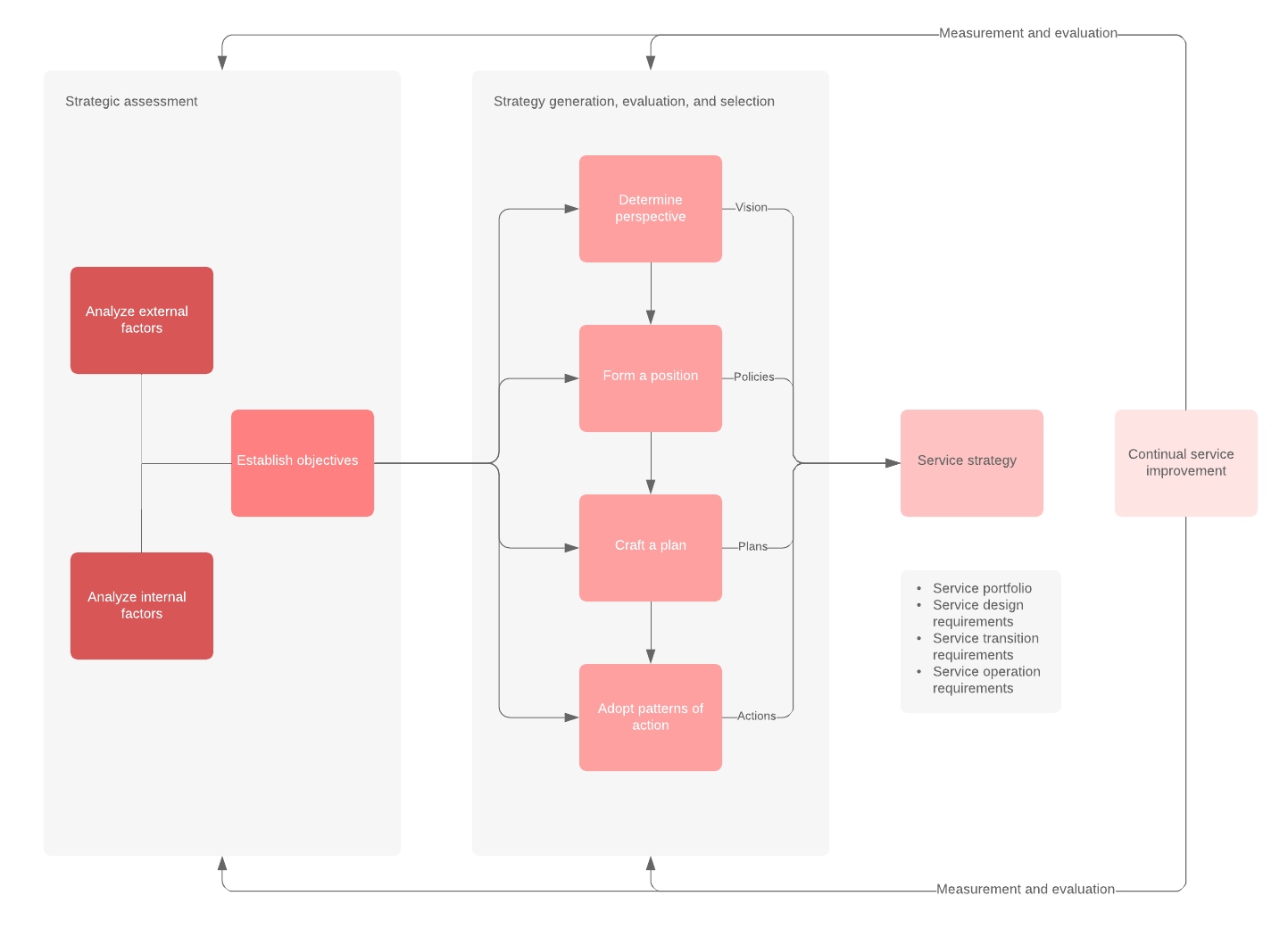In the fast-paced world of technology, IT service providers must be agile and strategic when making decisions about their service delivery. Businesses that understand customer needs and can predict and meet demand accurately can position themselves ahead of the competition.
That’s where ITIL Service Strategy comes in.
What is ITIL Service Strategy?
As a reminder: ITIL (which stands for Information Technology Infrastructure Library) is a set of best practices for IT service management that helps align IT services with business needs. ITIL uses a systematic approach that helps businesses manage risk, improve customer relations, increase efficiency, and build a stable, scalable IT environment.
How many phases are in the ITIl life cycle?
There are five stages of the ITIL service lifecycle:
- Service Strategy
- Service Design
- Service Transition
- Service Operation
- Continual Service Improvement
We will focus on the first stage of the ITIL lifecycle: service strategy.
ITIL service strategy is a market-driven stage. Service strategy helps organizations determine the types of services they should offer and the markets to target. The goal is to make strategic decisions when planning and delivering targeted services to drive long-term growth and success.
What are the four P's in service strategy?
There are four building blocks of the service strategy stage:
- Perspective: Describe your vision or direction for your services.
- Position: Compare your strategy with competitors to understand how to best position yourself in the market.
- Plan: Identify the actions you will take to achieve your goals and overarching vision.
- Pattern: The fundamental and ongoing actions your organization will take to run smoothly over time. This includes processes, policies, schedules, budgets, and management systems.
These four P’s guide your service strategy and play an integral role in how you outline and implement your service plans. Strategies that lack any of these components are less likely to succeed.

5 ITIL service strategy processes
There are five processes within the service strategy ITIL lifecycle stage:
- Strategy management for IT services
- Service portfolio management
- IT financial management
- Demand management
- Business relationship management
These processes work together to ensure IT service best practices that lead to continual improvement.
1. Strategy management for IT services
Strategy management for IT services is the first process under ITIL service strategy. The goal of strategic management is to ensure IT services and their management align with the organization. During this stage, you will assess, define, and execute strategies for your service offerings.
Assessment
Evaluate the current market position of the business or service provider. What opportunities or constraints impact your services? Consider your service offerings, current and target customers, and your competitors’ offerings.
Definition
Based on your assessment of the business and service climate, you can begin defining what goals your service provider should pursue, as well as identify and recommend services for different customer segments.
Execution
The final step is implementation. This step is all about planning your strategy for the successful execution of your strategic initiatives.
2. IT Financial Management
IT Financial Management (also known as financial management for IT services) focuses on service valuation. This process involves accounting, budgeting, and charging services so that the organization covers costs and generates profits for those services.
These three steps are known as the “ABCs” of Financial Management for IT Services.
Accounting
Accounting activities help you understand exactly what you’re spending on IT services.
Accounting processes should be overseen by a trained accountant and include running cost-benefit analyses, organizing costs by category (e.g., hardware, software, staff, overhead, infrastructure), and keeping detailed records of spending.
The purpose is to build an accurate picture of your costs so you can identify opportunities for cost savings and manage costs more efficiently.
Budgeting
An accurate budget is crucial for delivering IT services effectively and consistently. IT budgeting calculates and allocates the funding needed to keep services running smoothly and support the business’s overall IT service strategy.
The budget oversees three main IT spending categories:
- Capital expenditures
- Operational costs
- Strategic investments
Budget planning typically occurs once a year with regular monthly monitoring.
Charging
Charging covers the process of billing customers based on the services they use, which involves developing rates and a chargeback system that accounts for the cost and value of delivering each service.
3. Service portfolio management
Service portfolio management (SPM) monitors your services in the pipeline from start to finish. The goal of SPM is to ensure each service aligns with your service management strategy and organizational objectives. By monitoring your services end-to-end, you can more effectively justify service needs based on concrete business value.
A service portfolio has three parts:
- Service catalog
- Service pipeline
- Retired services catalog
The service catalog is an overview of all the services you currently offer to customers.
Your service pipeline contains any services that are not yet visible to the customer (such as those that are in the proposal or development stages). The pipeline also outlines projected service timelines and growth trajectories so you can understand the strategy and plans for each service.
The retired services catalog is essentially your services archived. Any retired services are recorded here with relevant documentation for your records. SPM follows each service through the pipeline from funding, design, and development to testing and deployment.
There are four steps to basic SPM:
- Define desired outcomes for a proposed service (or proposed changes to an existing service).
- Analyze the impact this new or changed service will have on your other services in the portfolio. Identify any needed resources to offer the service.
- Approve a new service (or change) with a formal proposal and initiate the design stage following authorization.
- Charter services, communicate decisions, and allocate resources for successful service deployment.
This process helps you make a business case for each service and answer questions like:
- Why does a customer need this service?
- What sets our service apart from competitors?
- What are the strengths and weaknesses of this service?
- How can we manage risk factors?
- What is the best way to allocate resources for this service?
Managing your service portfolio requires commitment and investment, but the benefits are clear. Good SPM helps customers understand exactly what services (and value) you deliver, improves transparency and communication around costs and risks, and increases efficiency in operations by tracking (and justifying) your services at every stage.
4. Demand management
Demand management helps businesses understand, predict, and influence customer demand for their IT services.
Accurately understanding and adapting to service demand ensures businesses avoid inadequate or excessive service capacity—both of which impact costs and customer satisfaction. Demand management typically involves three primary activities:
Analyzing
Analyze current customer use of services by tracking service desk data (e.g., number of incidents, requests, and problems), as well as network usage and uptime.
These data are called Patterns of Business Activity (PBA). You can use PBA to measure components of customer service usage like:
- Frequency
- Volume
- Duration
- Location
Anticipating
Communicate with your customers about their forecasted needs, track trends and rely on your data analysis to make educated predictions about future service requirements.
Influencing
Businesses sometimes need to influence customer service consumption to mitigate risks and expenses. For example, if a customer exceeds their expected service usage, this can add significant costs for the business to meet that demand. You can influence demand through financial or technical means, such as network throttling or charging fees for exceeding usage limits.
Accurately predicting service demand is crucial for meeting SLAs, KPIs, quality standards, and budget constraints.
5. Business relationship management
Business relationship management (BRM) focuses on developing strong client relationships. Relationship managers do this by optimizing the value of service delivery for the customer to ensure continued satisfaction and loyalty.
There are several processes for executing a successful BRM program:
- Maintain customer relationships.
- Identify service requirements.
- Acquire new customers.
- Solicit customer satisfaction feedback.
- Handle complaints.
- Monitor complaints and incidents.
BRM plays an integrated role at each stage of the ITIL lifecycle, ensuring that customer questions, needs, and complaints are understood and addressed.
The ITIL Service Strategy Lifecycle guides many processes, roles, and best practices. Lucidchart’s ITIL process templates can help you learn and implement these best practices successfully every time.
Leverage Lucid’s extensive collection of ITIL process maps, templates, process flows, and ITIL service lifecycle diagrams to build and track your processes, collaborate easily across the lifecycle, and optimize your service strategy.

IT teams van vooraanstaande bedrijven van over de hele wereld gebruiken de software van Lucid om IT systemen en processen te visualiseren en te optimaliseren
Ontdek Lucid voor IT-teamsAbout Lucidchart
Lucidchart, a cloud-based intelligent diagramming application, is a core component of Lucid Software's Visual Collaboration Suite. This intuitive, cloud-based solution empowers teams to collaborate in real-time to build flowcharts, mockups, UML diagrams, customer journey maps, and more. Lucidchart propels teams forward to build the future faster. Lucid is proud to serve top businesses around the world, including customers such as Google, GE, and NBC Universal, and 99% of the Fortune 500. Lucid partners with industry leaders, including Google, Atlassian, and Microsoft. Since its founding, Lucid has received numerous awards for its products, business, and workplace culture. For more information, visit lucidchart.com.
Related articles
How to strengthen your service operations and service desk strategies with Lucidchart
Optimize your service operations strategies by strengthening your service desk. Use Lucidchart to simplify your ITSM and ITIL processes and improve your service desk efficiency.
How to use visuals to drive strategy through challenging times
Learn more about the crisis management framework and how you can use visuals to drive efficiency, transparency, and collaboration during each phase.

